 Indexing is actually a highly engaging activity, isn’t it?
Indexing is actually a highly engaging activity, isn’t it?
Sure, we work alone. We may not even have a single face-to-face conversation all day. But as we get into reading the book in front of us, we go beyond being absorbed. We deeply engage on two fronts—with the meaning of the text and with the minds of the future readers.
One of the secrets to happiness is doing engaging work. And that’s why most of us wouldn’t choose to do anything else.
But there is a down side to this choice, especially for freelancers. We have to manage clients, projects, schedules and personal responsibilities. If we don’t, the stress piles up and that’s just not fun.
So, what can we do to balance on the edge of maximum happiness and minimum stress?
Nan Badgett will give us strategies at the conference in Winnipeg June 8-9.

